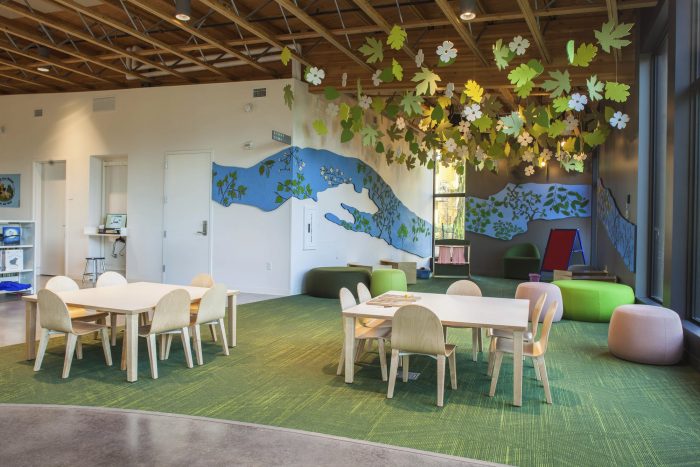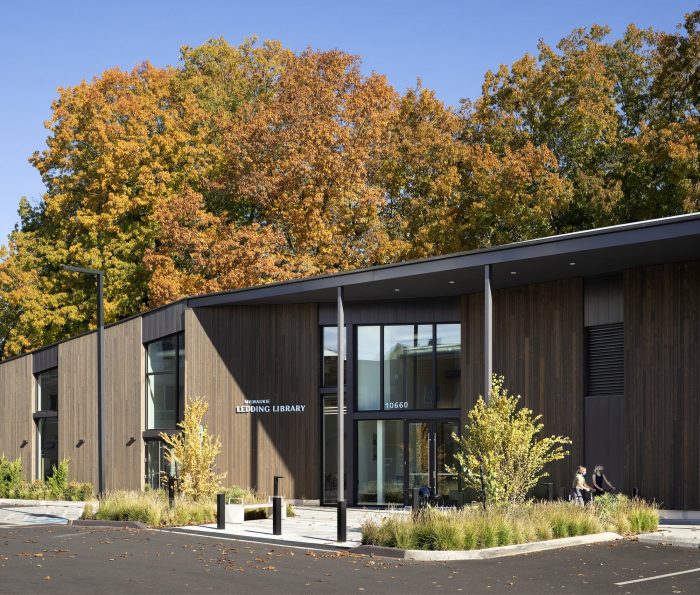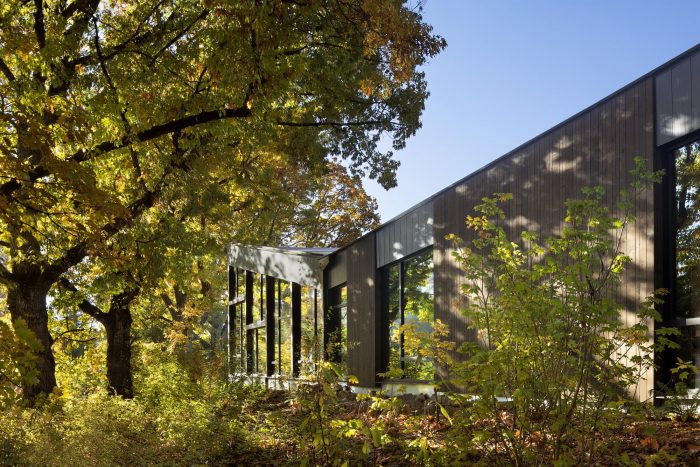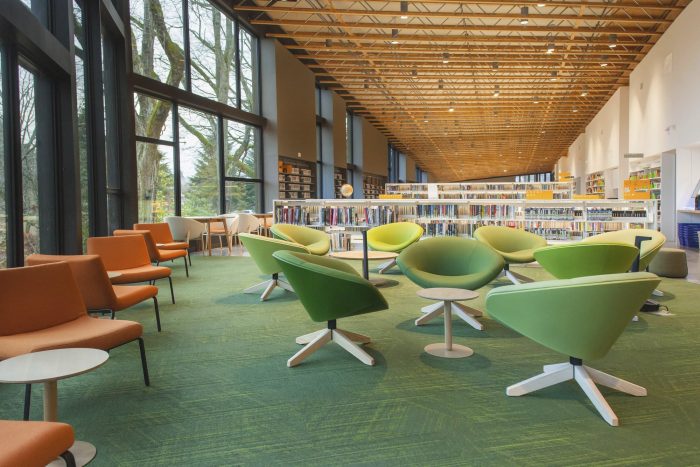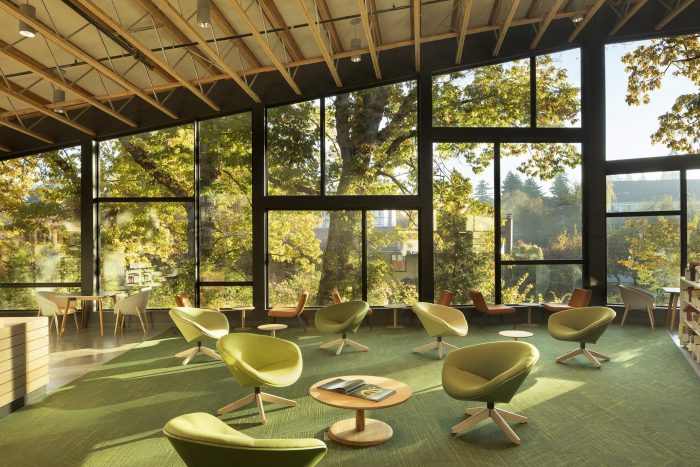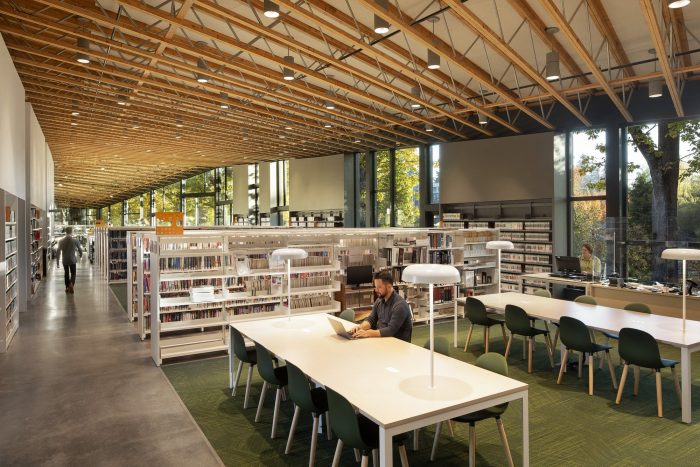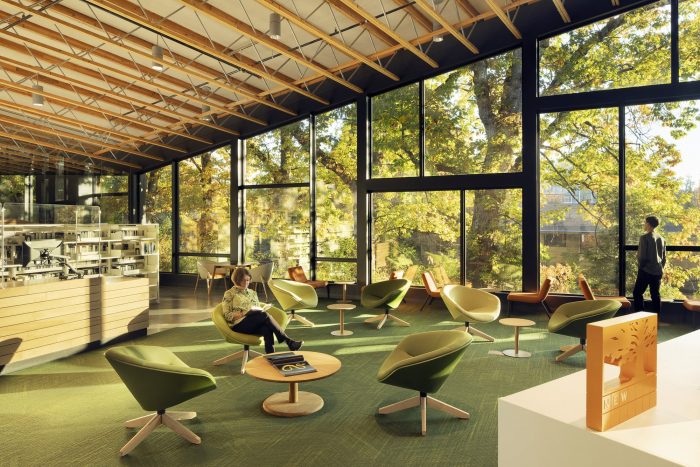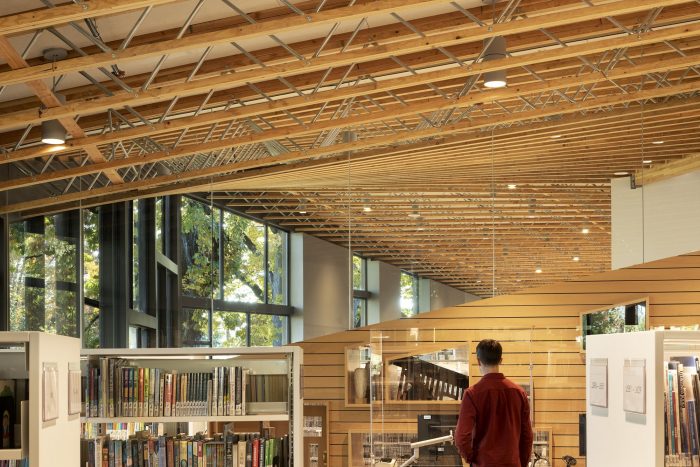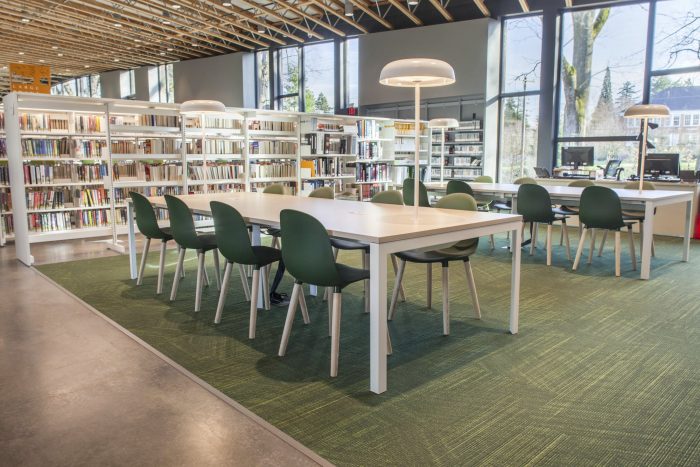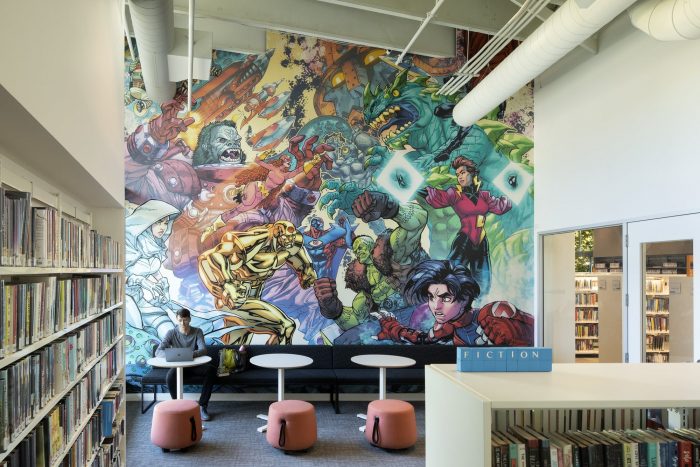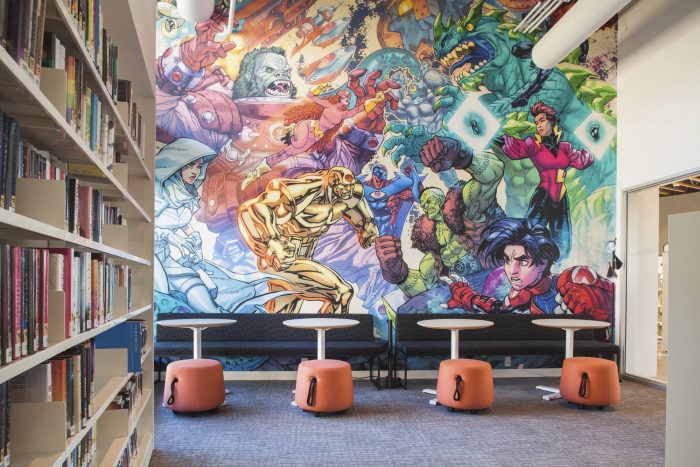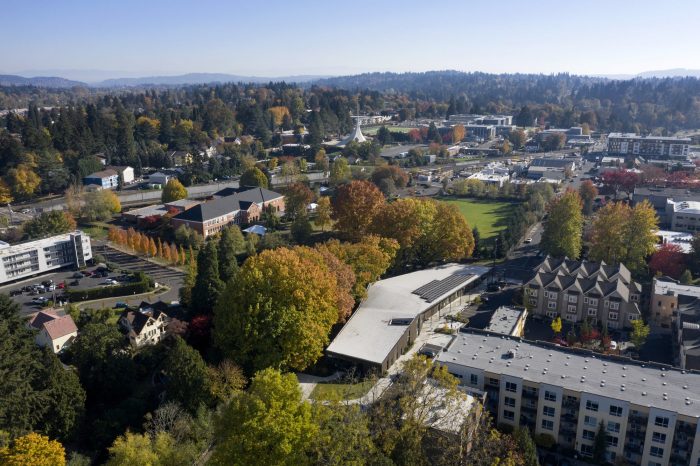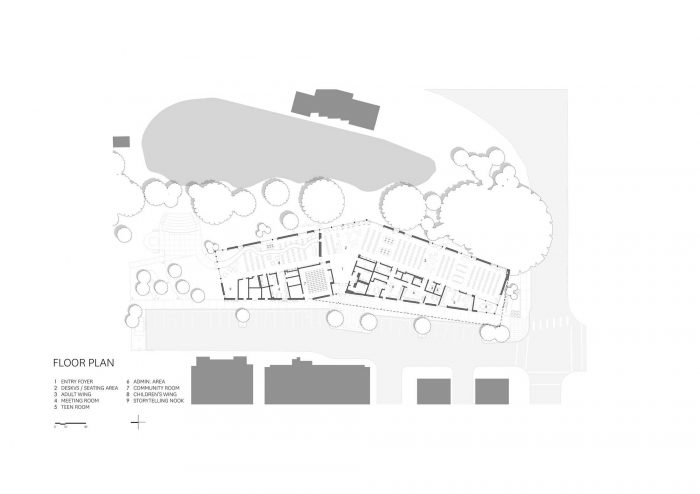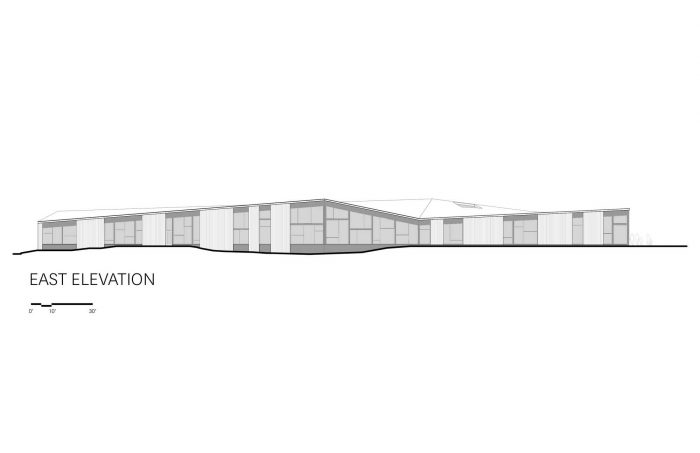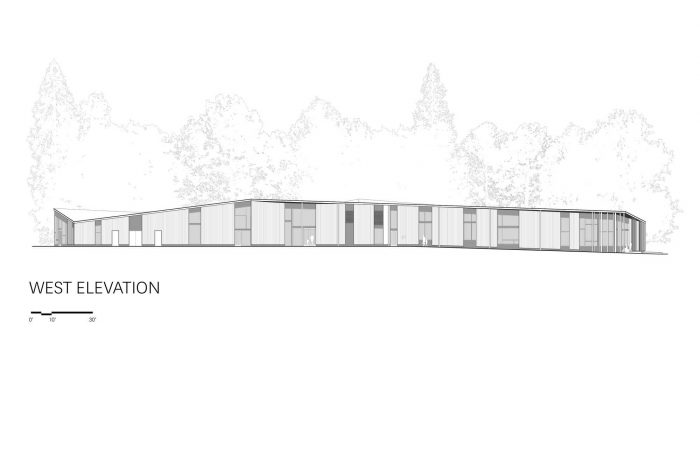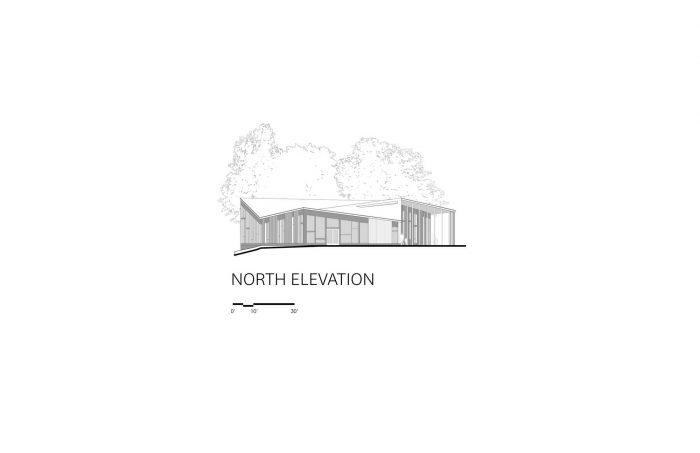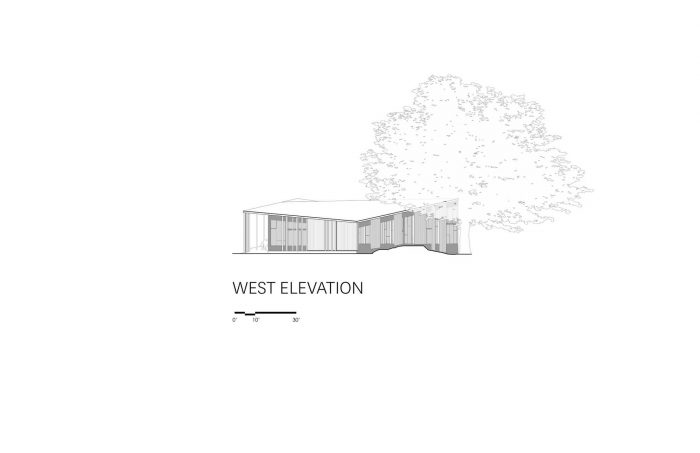新的20,000平方英尺的Ledding图书馆在俄勒冈州Milwaukie市中心的边缘占据了一个独特的位置,在一个湿地自然区、一个城市公园和市政厅之间。设计的目的是为图书馆创造一个公民形象,反映其在密尔沃基的历史、社区和市中心核心区的尊贵地位,同时利用独特的自然环境。它的形式从河流的自然运动中获得灵感,弯曲穿过场地以捕捉邻近的传统橡树和水道的广阔视野。外部和内部大量使用木材,有助于图书馆与周围环境相融合,创造一个温暖、欢迎、充满活力的氛围。新图书馆的愿景是由图书馆工作人员、社区成员和市议会共同制定的四个主要原则驱动的。
The new 20,000-square-foot Ledding Library occupies a unique position at the edge of downtown Milwaukie, Oregon, between a wetland natural area, a city park, and City Hall. The design aims to create a civic presence for the library, reflecting its esteemed position in Milwaukie’s history, community, and downtown core, while taking advantage of the unique natural setting. Its form draws inspiration from the natural movement of rivers, bending across the site to capture sweeping views of the neighbouring heritage Oak trees and waterway. Extensive use of wood on both the exterior and interior help to blend the library with its surroundings, creating a warm, welcoming, vibrant atmosphere. The vision for the new library was driven by four main principals developed with library staff, community members, and city council.
人。提供一个充满活力的社区信息枢纽,使人们聚集在一起,激发想象力,丰富生活。繁荣。提供一个创新的、最先进的、具有未来思维的图书馆,支持社区和个人的努力。地球。该建筑增强了对周围景观的体验,是可持续发展和环境恢复设计的典范。地点。图书馆是一个受欢迎的公民焦点,促进教育和对Milwaukie的文化、社区和历史的了解。
People: Provide a vibrant community information hub that brings people together, stimulates imagination, and enriches lives. Prosperity: Provide an innovative, state of the art, future thinking library that supports both community and individual endeavors. Planet: The architecture enhances the experience of the surrounding landscape and is a model of sustainable and environmentally restorative design. Place: The library is a welcoming, civic focal point that promotes education and understanding of Milwaukie’s culture, community, and history.
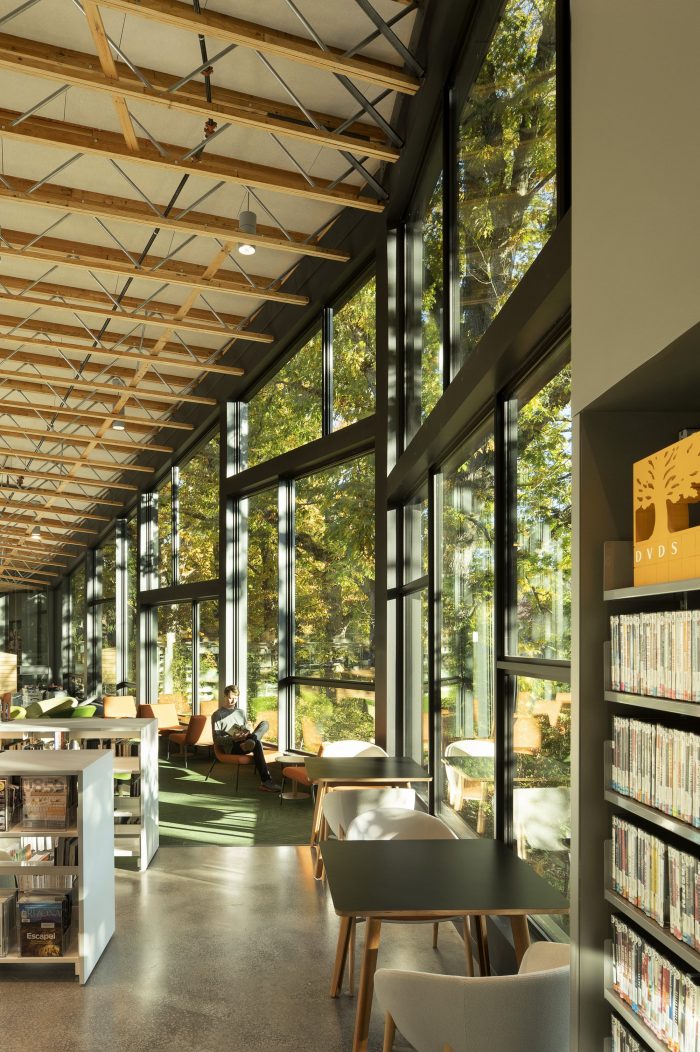
最初的图书馆于1962年开放,占用了佛罗伦萨-奥尔森-莱丁捐赠的旧居。在原来的房子上增加了三栋楼,造成了结构和公共设施的复杂性,并对图书馆的可及性、运作和灵活性提出了挑战。在现有场地上建造新馆的决定将重点转移到利用该场地最强大的属性上:它毗邻风景优美的湿地池塘和威拉米特河的支流。停车场被重新配置为沿着整个场地的西部边缘运行,缓冲了与邻近公寓楼的毗邻关系,并将景观和自然区域整合到东部的水路边。沿着东部立面的大窗户,在大橡树的遮挡下,与阅读的座位区一致,可以直接看到树木和池塘。西部立面的热增益被控制在较窄的窗户和一个宽大的入口顶棚上,提供午后的遮阳。
The original library opened in 1962 and occupied the donated, former home of Florence Olsen Ledding. Three additions were added to the original house creating structural, and utility complexities and challenges for accessibility, library operations, and flexibility. The decision to build new on the existing site shifted focus to capitalizing on the site’s strongest attribute: its adjacency to a scenic wetland pond and tributary to the Willamette River. The parking lot was reconfigured to run along the full western edge of the site, buffering the adjacency to neighboring apartment buildings and consolidating landscaped and natural areas to the east, along the waterway. Large windows along the eastern façade, shaded by large oaks, align with seating areas for reading with direct views out to the trees and pond. Thermal gain is controlled on the western facade with narrower windows and a broad entry canopy, providing afternoon shade.
内部开放的图书馆环绕着员工空间、一个大型社区活动室、小型会议空间和建筑服务。读者从建筑的中心进入,受到橡树和邻近池塘的突出景观的欢迎。成人区和儿童区被拉开到建筑形式的对立面,以达到声学和程序上的分离。起伏的天花板形式从水流中获得灵感,具体的几何形状受外部条件和影响,如悬垂的橡树树冠,以及内部空间塑造的驱动。
The interior open library wraps around staff spaces, a large community room, small meeting spaces and building services. Patrons enter at the center of the building, welcomed by the prominent view to the Oaks and neighboring pond. Adult and children’s areas are pulled apart into the opposing reaches of the building form for acoustic and programmatic separation. The undulating ceiling form takes inspiration from the flow of water, the specific geometry being driven by exterior conditions and influences, such as the overhanging Oak canopy, as well as interior space shaping.
忠实于愿景,图书馆有一个高效的水力辐射板机械系统,用于加热和冷却开放的图书馆空间。窗户的位置和大小都经过优化,以利于日光和热控制。屋顶安装的40kW光伏阵列进一步抵消了能源使用。图书馆严密的热围护结构使该建筑符合2030年挑战赛的要求。
Holding true to the vision, the library has a highly efficient hydronic radiant slab mechanical system for heating and cooling the open library space. Window placements and sizes are optimized for daylight and thermal control. A roof-mounted, 40kW PV array further offsets energy use. The library’s tight thermal envelope makes the building 2030 Challenge-compliant.
Architects: Hacker Architects
Area : 20000 ft²
Year : 2020
Photographs :Jeremy Bittermann
Strcutural Engineers : ABHT Structural Engineers
Main Contractor : Swinerton
Design Team : Jennie Fowler, David Keltner, Laura Klinger, Scott Mannhard, Tyler Nishitani, Matt Sugarbaker, Janell Widmer
Client : City of Milwaukie
City : Milwaukie
Country : United States


